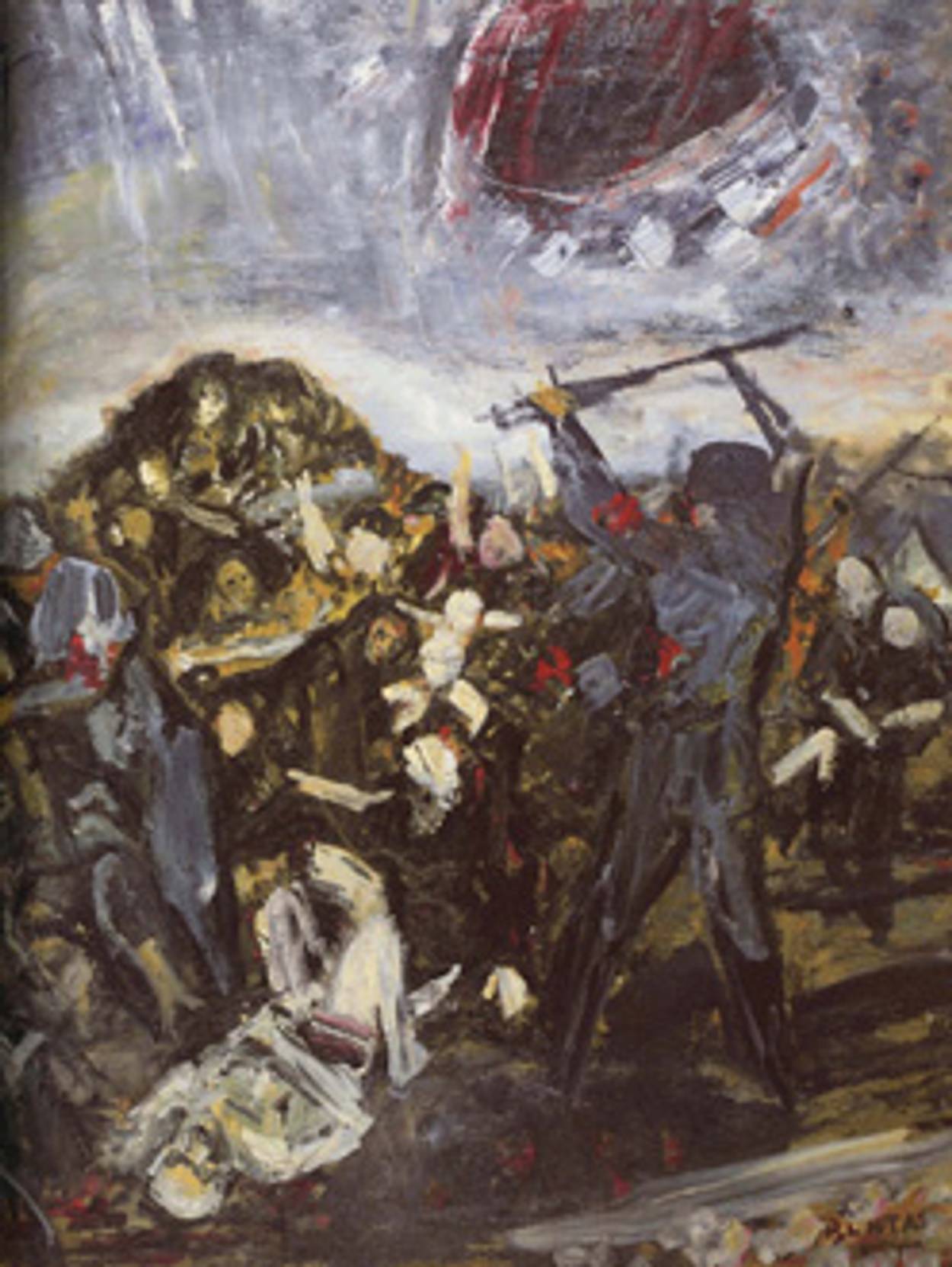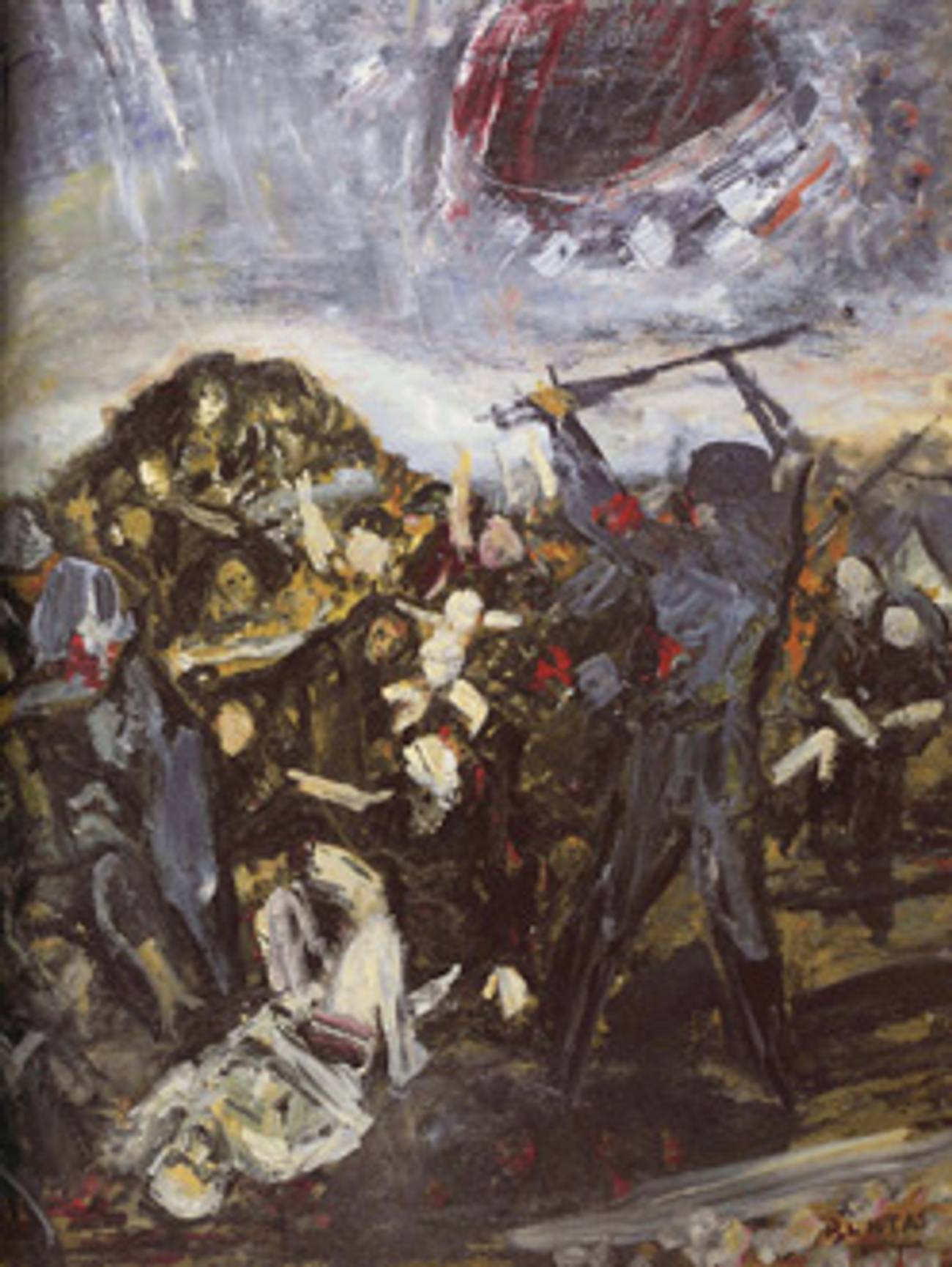Moving Pictures
In his late artworks, Arbit Blatas took on the Holocaust




When NBC aired the Holocaust miniseries in April 1978, it was a watershed moment, bringing a subject still largely taboo to the broad public consciousness. But neither this feat, nor a host of accolades, inured the show from charges that it trivialized and sentimentalized the atrocities. It would be difficult to launch similar critiques against the stark black-and-white drawings commissioned by Holocaust’s producers to introduce each segment of the eight-hour saga. These rough-hewn renderings of brutality, by the Lithuanian-born artist Arbit Blatas, appeared onscreen as historical stage-setters, lending gravitas and an air of authenticity to the unfolding drama.
The producers approached Blatas, who was born in 1908 and fled Nazi-occupied Europe in 1941, having seen a forceful lithograph he made depicting the Babi Yar massacre, a subject he also treated in an epic 1944 oil (when the fate of his parents, whom he had left behind, was uncertain). It is currently on view in an exhibition at Hebrew Union College (HUC) celebrating the centenary of Blatas’s birth—and bringing together, for the first time, major examples from every period of his long career. He died in 1999, at 90.
Babi Yar is an angry, almost barbaric painting, with brushstrokes rendered like stabs, though it still exhibits the artist’s trademark expressionism, giving the work a universal power beyond its deeply personal roots. A contorted heap of faceless bodies is tormented by Nazi officers, distinguished from the mass by their bluish uniforms and blurred, blood-red swastikas, under a bruised purplish sky flecked with gray and white. It is one of the most significant paintings of the Holocaust, offering a rare representational depiction of a contemporaneous event that was gleaned only through scant news reports, and it predated by nearly two decades the Yevtushenko poem that would make the killing site notorious. But upon its completion, Blatas returned to the more exuberant images for which he was celebrated, primarily cityscapes, portraits, and theatrical works.
The artist’s renderings of the light-filled cities where he made homes—Paris, New York, and Venice—showcase his talent as a vivid colorist, while his portraits of fellow École de Paris artists (those émigrés seeking refuge in the city between the wars) suggest a keen understanding of his sitters that goes well beyond likeness. At 21, he became the youngest member of this group, joining an avant-garde circle that included Picasso, Matisse, Braque, Dufy, Utrillo, Vlaminck, Soutine, and Lipschitz. More than 100 of these portraits were placed on permanent display at the Museum of the Thirties in Boulogne-Billancourt outside Paris a decade ago, shortly before Blatas’s death. On more than one occasion, he also rendered with great tenderness his dear friend and kindred spirit, the mime Marcel Marceau.
During the 1970s, in collaboration with his wife, the mezzo-soprano and stage director Regina Resnik, Blatas designed sets and costumes for nine productions, including Elektra for the Teatro La Fenice, Falstaff for Warsaw’s Grand Theater, and Carmen for Hamburg’s State Opera. These works, as well as numerous studies based on The Threepenny Opera (which he saw at its 1928 world premiere in Berlin and would revisit time and again during its run at Greenwich Village’s Theater de Lys in the 1950s), powerfully fuse color and emotion. Blatas’s particular affinity for Threepenny’s beggars—he featured them in some of his most poignant pictures and, in 1952, created a set of 10 tabletop bronzes in an edition of six, depicting them in loving, lyrical detail—exemplifies his joyful approach to art and life, even as he acknowledged its underside.
Sitting in the West 56th Street atelier where Blatas lived and worked from the time he settled in New York—the walls and floors still covered with his artworks and even his brushes carefully preserved on a mantel—Resnik, his widow, tells me, “He fell in love with the beggars and would say that he followed them around all his life, and they followed him.” By contrast, the Holocaust works were unexpected.
The NBC commission awakened buried emotions, Resnik says, inspiring what may have been his most important work. At that point, Blatas knew that his mother had perished at Stutthof, and his father, who survived Dachau and found his son in America by tracking down Picasso, had died. After sitting through a marathon viewing of footage for Holocaust, Resnik recalls, Blatas immediately agreed to do the project. He was similarly moved after the couple attended the docudrama’s premiere. Two days later, they set sail for Venice, where Blatas had a studio on the island of Giudecca, the city’s first Jewish settlement. En route, he was very pensive, and upon arrival, he spent 40 days and nights at his foundry, not stopping his work until he had completed seven bas-relief sculptures in the form of narrative plaques based on (and taking their titles from) the miniseries drawings.
In 1980, this monument to the Holocaust was erected on a brick wall in the Venice Ghetto still trimmed with barbed wire, as a public memorial to the first 200 Jews rounded up for deportation in December 1943. The following year, another casting was placed by the Shrine of the Unknown Jewish Martyrs in Paris, and the year after that, a third set was installed outside the former headquarters of the Anti-Defamation League (ADL) at Dag Hammerskjold Plaza in New York. (The HUC show marks the reemergence of the ADL plaques, which went into storage when the organization sold its building two years ago and were recently donated to the College.) Posthumously, Resnik found an appropriate home for the final edition: the infamous Fort Nine in Kaunas, Lithuania, Blatas’s birthplace.
As in his upright, three-dimensional figurative sculptures, Blatas modeled the clay almost entirely with his bare hands, using tools sparingly to chisel subtle crevices. But the myriad indentations of his fingertips, so effective in conveying a distinctive combination of blunt realism and tender emotion, translate as more battered than expressive here because of the subject and scale. In the absence of color, chiaroscuro creates plays of shadow and light off the mostly rough, unpolished surface. Simultaneously, Blatas painted two more Holocaust canvases—The Final Solution and The Deportation. The Last Train would follow in 1990, the year that a bas-relief of the same title was added to the Venice Ghetto memorial, along with names of all the city’s victims. All three are more carefully executed than Babi Yar but no less stirring, depicting similar masses of twisted, faceless figures, suffering beneath burnt orange skies streaked with smoky gray.
Many museums dedicated to the Holocaust focus their art exhibits on work by victims and survivors, avoiding curatorial judgment and treating these expressions as testimony. This earnest approach protects the legacy of the calamity but tends to discount artistic merit and leave little room for other worthy contributions, no matter their integrity or skill. As an accomplished, masterful artist—and as a witness who escaped the maelstrom—Blatas brings a necessary complexity.
Jeannie Rosenfeld, a former editor at Art + Auction magazine, is a New York writer specializing in fine and decorative art. Her work has appeared in ARTnews, Interior Design, and the Forward.
Jeannie Rosenfeld, a Tablet Magazine contributing editor, writes about fine and decorative art.